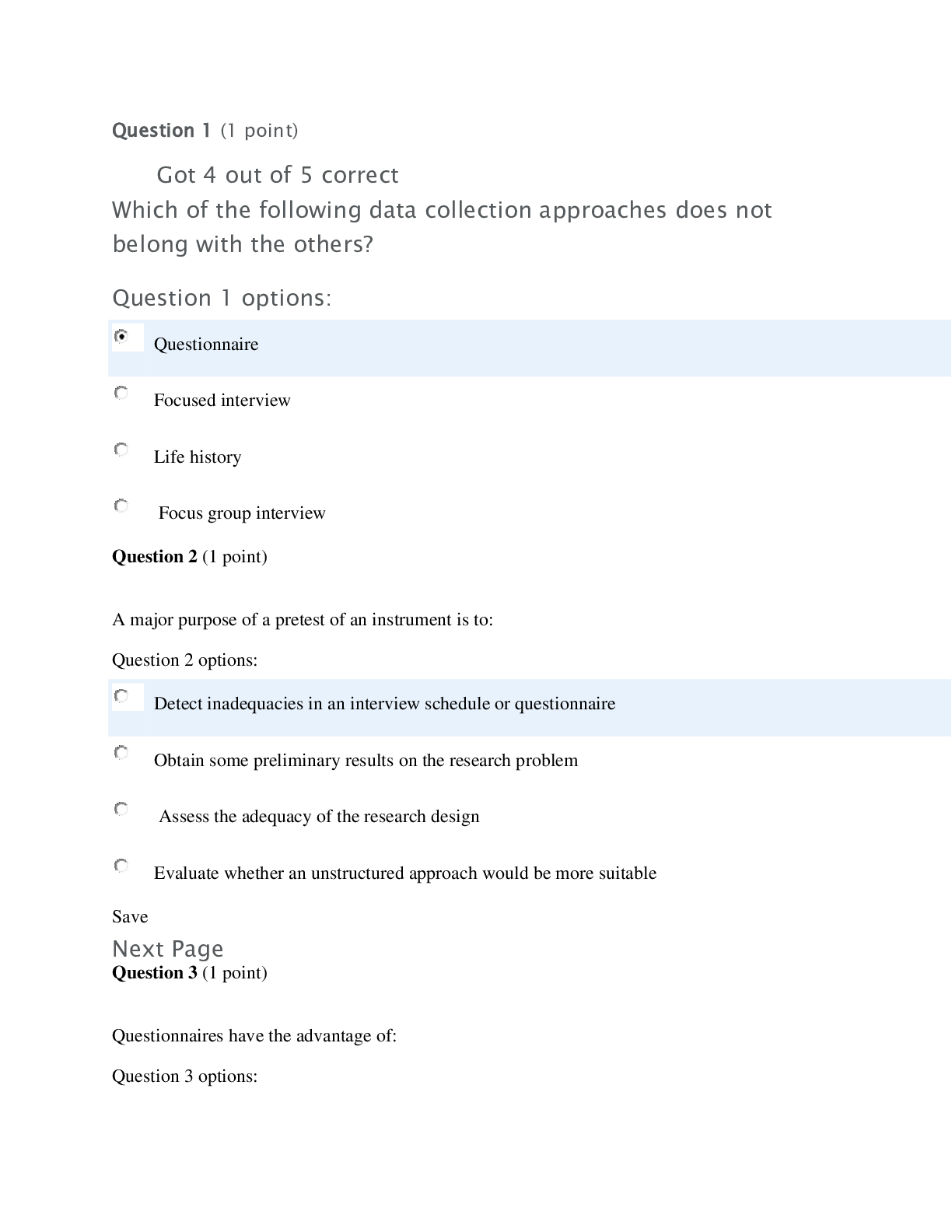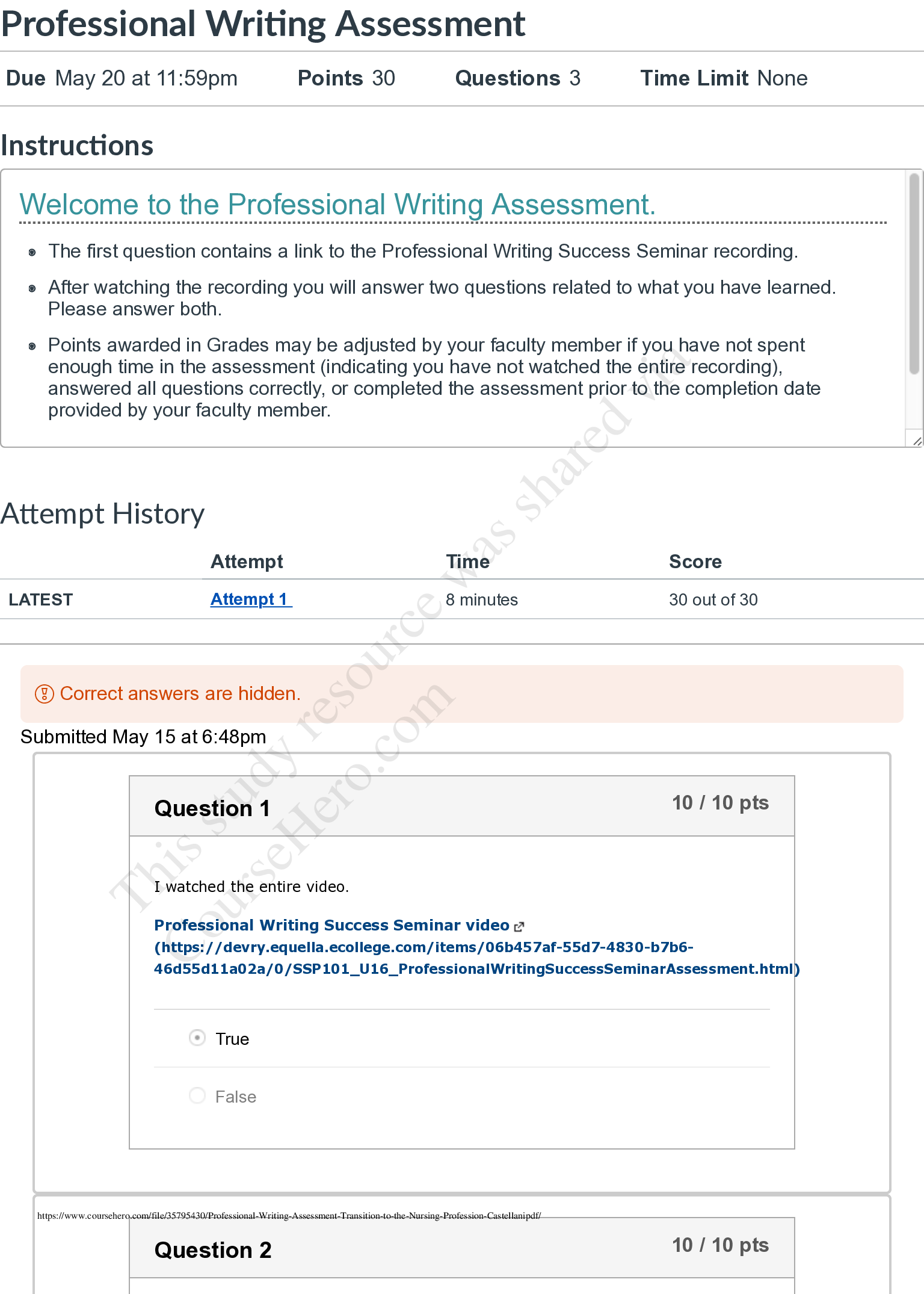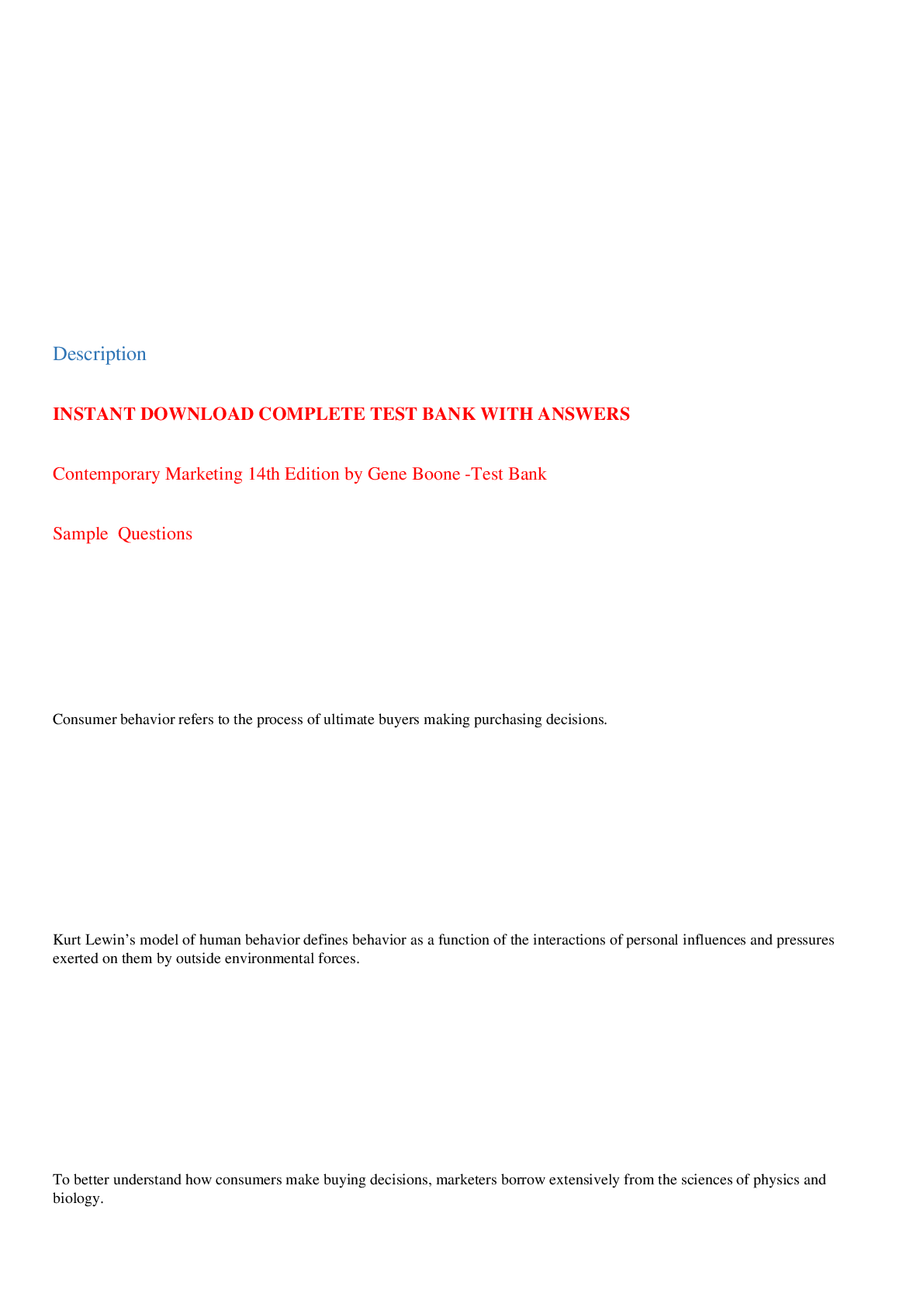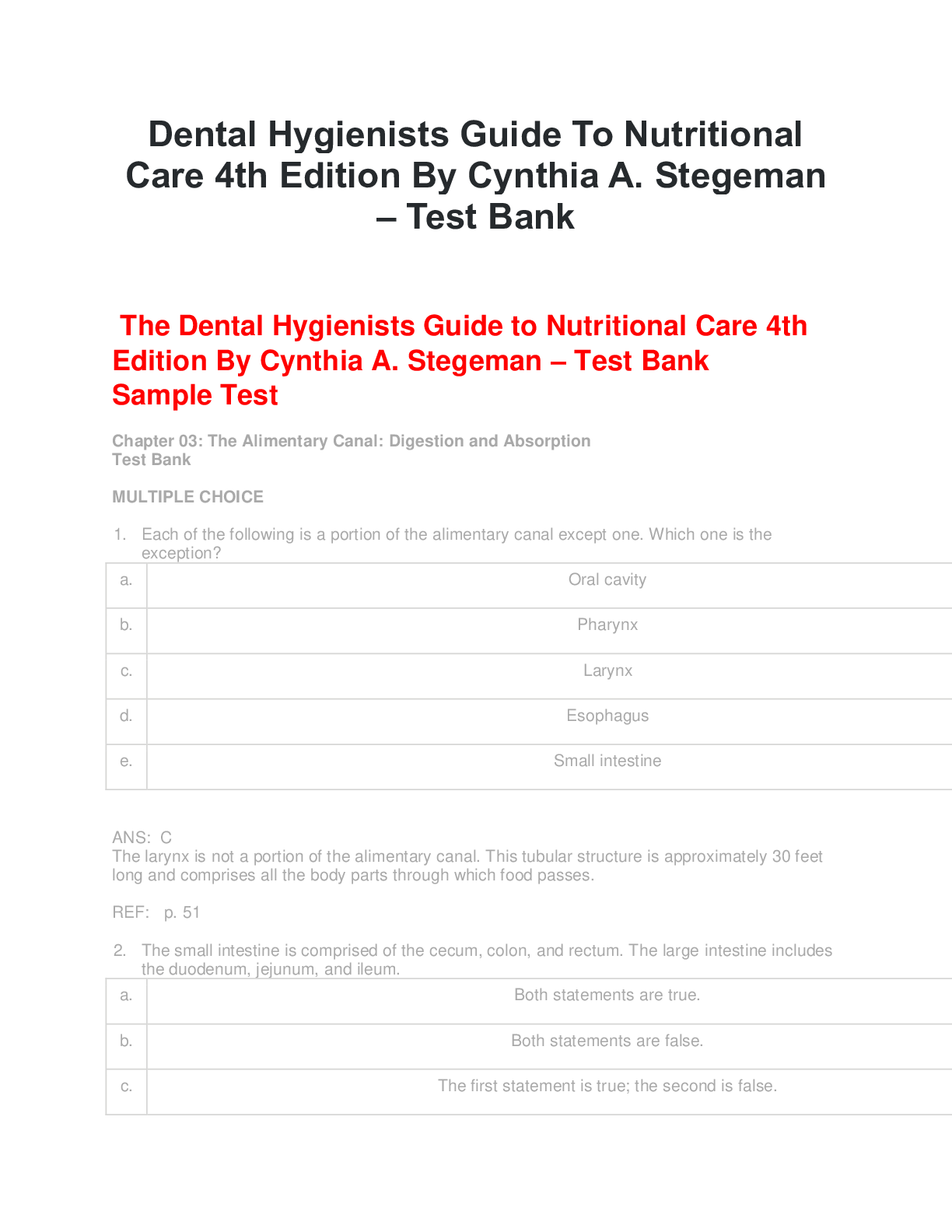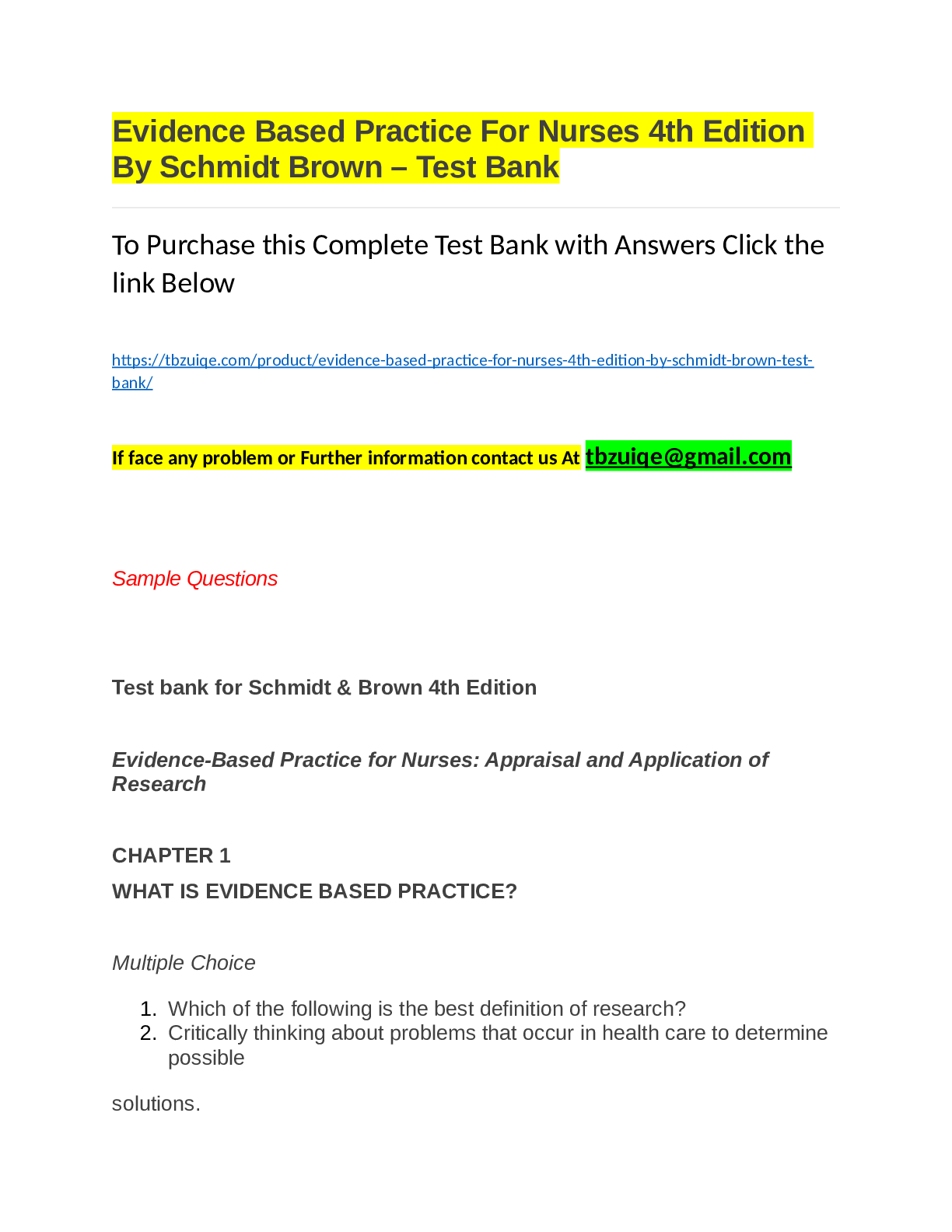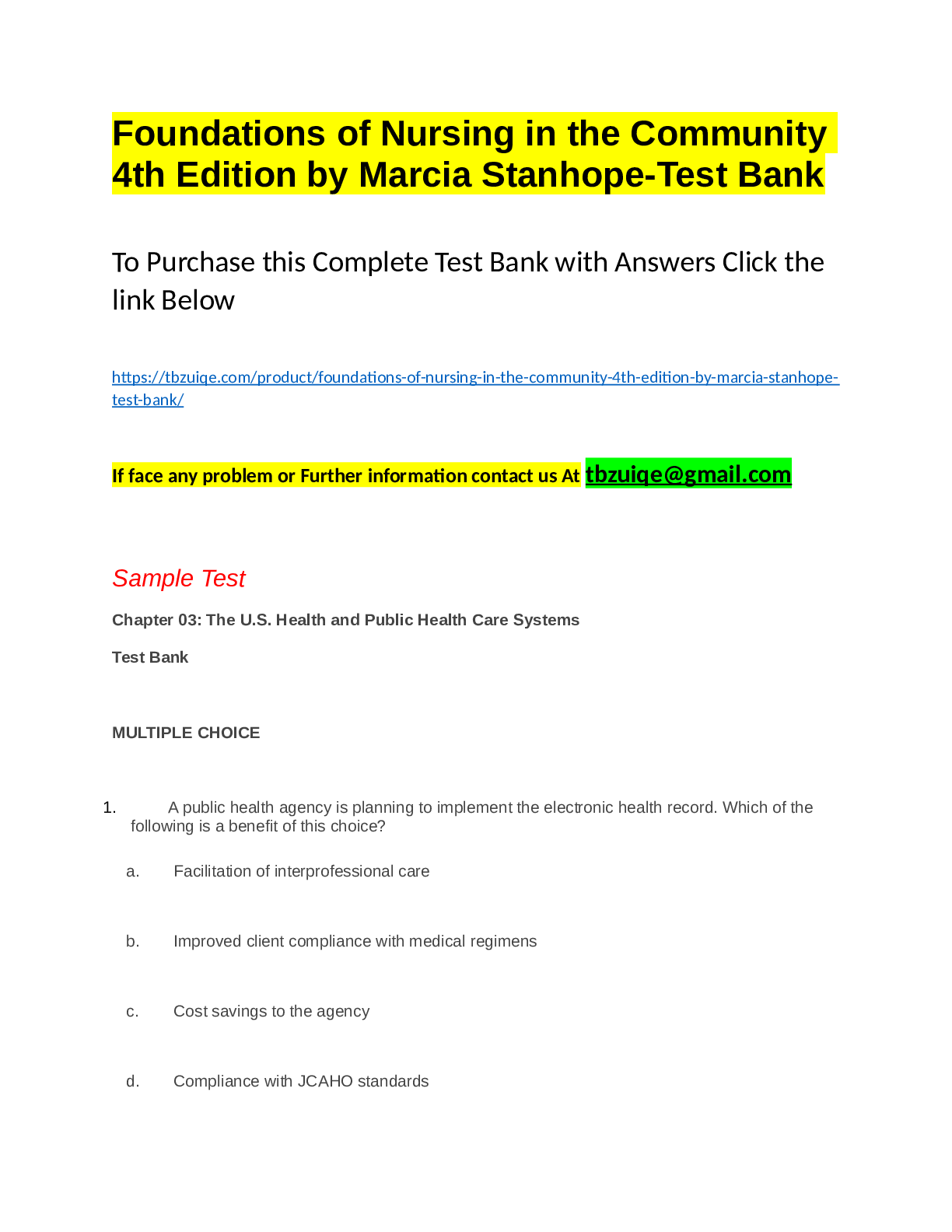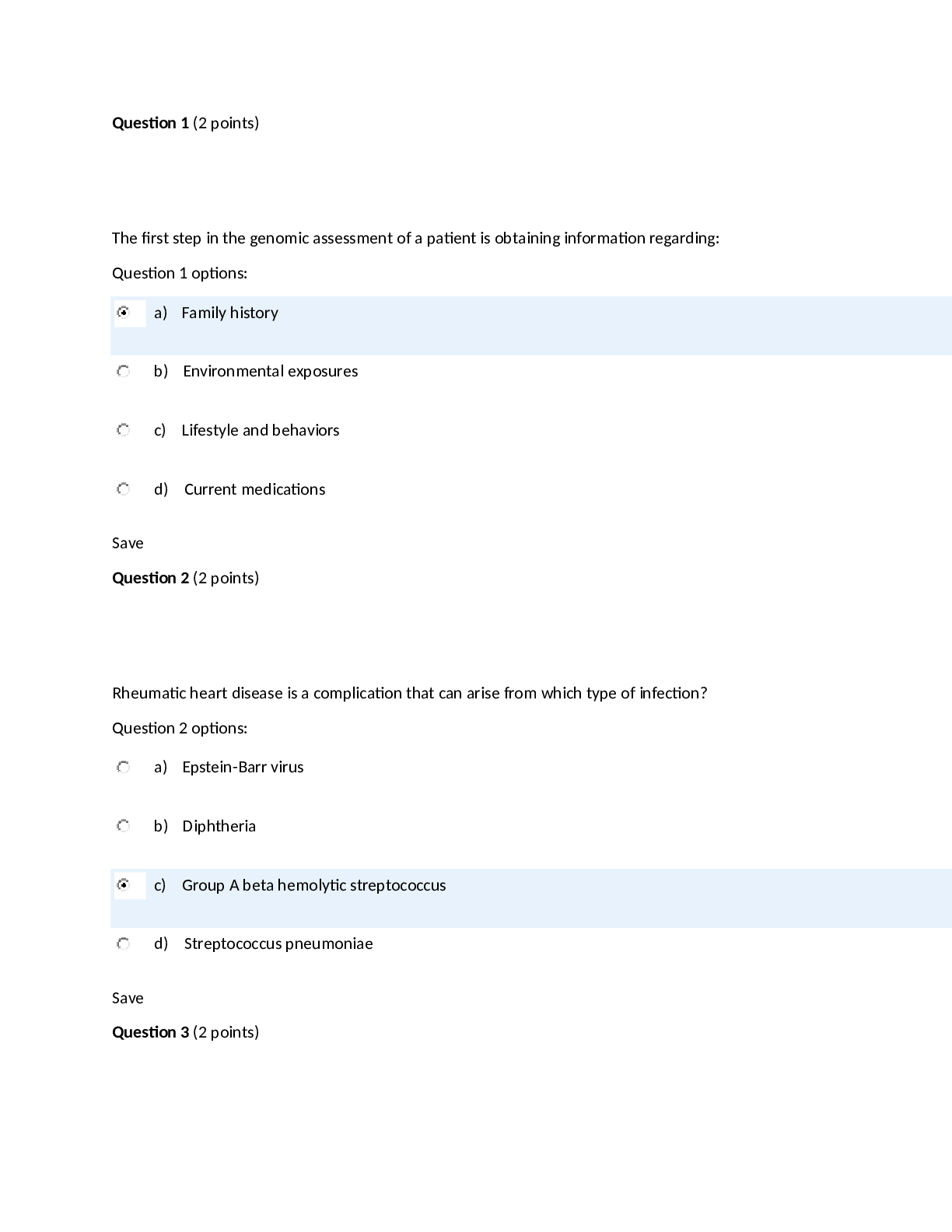*NURSING > EXAM > Foundations Of Mental Health Care 4th Edition by Morrison-Valfre – Test Bank (All)
Foundations Of Mental Health Care 4th Edition by Morrison-Valfre – Test Bank
Document Content and Description Below
Foundations Of Mental Health Care 4th Edition by Morrison-Valfre – Test Bank Sample Test Morrison-Valfre: Foundations of Mental Health Care, 4th Edition Test Bank Chapter 3: E... thical and Legal Issues MULTIPLE CHOICE 1. A male teenage client tells the nurse that his friends like to drink alcohol occasionally to get drunk. The client’s friends see nothing wrong with their drinking habits. The client states that he was taught by his parents and agrees that underage drinking is not acceptable. Also, he has never seen his parents drunk; therefore, he refuses to drink with his friends. Which mode of transmission best describes how this client’s particular value was formed? a. Moralizing b. Modeling c. Reward-punishment d. Laissez-faire ANS: B Modeling best describes how the teenage client developed this value because his parents not only discussed this issue but behaved in a way for the teen to copy. Moralizing sets standards of right and wrong with no choices allowed; the reward-punishment model rewards valued behavior and punishes undesired behavior; and the laissez-faire model imposes no restriction or direction on choices. DIF: Cognitive Level: Application REF: Page 20 OBJ: 1 TOP: Acquiring Values KEY: Nursing Process Step: Assessment MSC: Client Needs: Psychosocial Integrity 2. A female client becomes combative when the nurse attempts to administer routine medications. The nurse would like to ignore the client but chooses to talk with the client to calm her. The nurse is successful in calming the client, and the client takes her medications. What process best describes how the nurse decided on the course of action taken? a. Values clarification b. Nurse’s rights c. Beliefs d. Morals ANS: A Values clarification consists of the steps of choosing, prizing, and acting. This most accurately describes how the nurse made the proper decision. The nurse chose the best action, reaffirmed the choice, and then enacted the choice. The nurse’s rights were not violated, and beliefs and morals do not describe the entire decision-making process that occurred. DIF: Cognitive Level: Application REF: Page 20 OBJ: 1 TOP: Values Clarification KEY: Nursing Process Step: Intervention MSC: Client Needs: Safe and Effective Care Environment 3. Which patient right may clients with mental health disorders lose during treatment? a. Confidentiality of records b. Freedom from restraint or seclusion c. Humane treatment environment d. Referral to other mental health providers on discharge ANS: B A client could lose the right of freedom from restraint or seclusion in emergency situations, such as being a threat to himself or others. The other rights must be upheld at all times. DIF: Cognitive Level: Knowledge REF: Page 21 OBJ: 2 TOP: Client Rights KEY: Nursing Process Step: Intervention MSC: Client Needs: Safe and Effective Care Environment 4. Twenty three states have enacted mental health parity laws. The most accurate description of these laws is that they require insurance companies to: a. Include coverage for mental illness b. Include coverage for substance abuse treatment c. Include coverage for mental illness that is equal to coverage for physical illness d. Include coverage for outpatient therapy for individuals with substance abuse ANS: C The mental health parity laws require insurance companies to include coverage for mental illness that is equal to coverage for physical illness. Only nine states include treatment for substance abuse in their parity laws. DIF: Cognitive Level: Knowledge REF: Page 21 OBJ: 2 TOP: Client Rights KEY: Nursing Process Step: Assessment MSC: Client Needs: Safe and Effective Care Environment 5. The rights of the care provider include the right to: a. Fair pay b. Fair benefits from employers c. Refuse to care for individuals who may cause harm to the care provider d. Respect as individuals ANS: D In addition to the right to respect as individuals, the rights of the care provider include the rights to safety, competent assistance, set standards for quality and development of policies that affect client care, and full and equal participation as a member of the health care team. Fair pay and benefits are not addressed by care provider rights. A care provider has the right to safety but cannot refuse to care for an individual because he may fear harm from the client. Proper safety measures must be implemented. DIF: Cognitive Level: Knowledge REF: Page 21 OBJ: 1 TOP: Care Provider Rights KEY: Nursing Process Step: Evaluation MSC: Client Needs: Safe and Effective Care Environment 6. The Nurse’s Code of Ethics includes the main concepts of autonomy, beneficence, justice, and: a. Rights b. Morals c. Nonmaleficence d. Prudence ANS: C Nonmaleficence is the fourth main concept of the Nurse’s Code of Ethics. The concept is that the nurse must do no harm to the client. Rights are a power or privilege that a person has just claim to, morals are a person’s belief regarding what is right or wrong, and prudence refers to the ability to judge between virtuous and vicious actions. DIF: Cognitive Level: Knowledge REF: Page 21 OBJ: 3 TOP: Ethical Principles KEY: Nursing Process Step: Assessment MSC: Client Needs: Safe and Effective Care Environment 7. The client is feeling very anxious and has requested that a p.r.n. antianxiety medication be ordered. The nurse informs the client that the medication can be administered only every 4 hours and was given 3 hours ago. The nurse promises to give the client the medication as soon as it is due, but the nurse goes to lunch 1 hour later without giving the client the medication. Which ethical principle did the nurse violate? a. Fidelity b. Veracity c. Confidentiality d. Justice ANS: A Fidelity refers to the obligation to keep one’s word. The nurse violated this principle in this situation, which leads to mistrust from the client. Veracity is the duty to tell the truth, confidentiality is the duty of keeping the client’s information private, and justice indicates that all clients must be treated fairly, equally, and respectfully. DIF: Cognitive Level: Application REF: Page 22 OBJ: 3 TOP: Ethical Principles KEY: Nursing Process Step: Intervention MSC: Client Needs: Safe and Effective Care Environment 8. A male client is seeking help in a mental health clinic for anger management problems. He voices that he is fearful that his wife may divorce him because of his anger problem, and he is willing to do “whatever it takes” to control his anger. Later in the week, the client’s wife also seeks assistance because she is going to divorce her husband. The nurse who is caring for both of these clients tries to decide the correct action to take. The nurse is experiencing: a. A moral dilemma b. Value clarification c. An ethical conflict d. A breach of confidentiality ANS: C This is an example of an ethical conflict or ethical dilemma. The nurse wants to help both clients but must maintain confidentiality for each. Use of guidelines for ethical decision making can assist the nurse in making an ethical decision. A moral dilemma is simply a dilemma associated with making a decision between right and wrong. Value clarification is a process that helps to identify an individual’s values. DIF: Cognitive Level: Application REF: Page 22 | Page 23 OBJ: 3 TOP: Ethical Conflict KEY: Nursing Process Step: Intervention MSC: Client Needs: Safe and Effective Care Environment 9. The psychiatrist asks the nurse to perform a procedure that she is not familiar with, and the nurse is unsure whether this is something within the scope of practice. Where can the nurse find the answer to her question? a. National nurse practice act b. State nurse practice act c. Regional nurse practice act d. Community nurse practice act ANS: B Each state’s board of nursing determines the scope of practice in that state through a series of regulations that are called nurse practice acts. It is the nurse’s responsibility to know his or her scope of practice. The other options do not exist. DIF: Cognitive Level: Comprehension REF: Page 23 OBJ: 4 TOP: Legal Concepts in Health Care KEY: Nursing Process Step: Intervention MSC: Client Needs: Safe and Effective Care Environment 10. An order written by a physician is reviewed by the nursing staff, and no one is familiar with the treatment instructions. A nurse who was recently hired knows that this treatment is covered by the state’s nurse practice act. What is the nurse’s best course of action? a. Call the physician to ask for clarification b. Check the state’s nurse practice act again c. Contact the nursing supervisor for approval to carry out the treatment d. Refer to the facility’s policy and procedure to determine the course of action ANS: D Because this treatment is covered under the state nurse practice act, the next step is to refer to the facility’s policy and procedure manual to determine whether the ordered treatment is allowed by the facility. Calling the physician is not necessary because there was no question about how the order was written, and the state’s nurse practice act has already been checked. Contacting the nursing supervisor would be acceptable only after the facility’s policy has been checked. DIF: Cognitive Level: Application REF: Page 23 | Page 24 OBJ: 4 TOP: Legal Concepts in Health Care KEY: Nursing Process Step: Intervention MSC: Client Needs: Safe and Effective Care Environment 11. Standards of nursing practice for mental health can best be described as helping to ensure: a. That certain clients receive care b. Quality and effectiveness of care c. Proper documentation d. Proper medication administration ANS: B Most health care disciplines have standards of practice documented as guidelines with measurable criteria that can be used to evaluate the quality and effectiveness of care provided. All clients have the right to receive care, so standards of nursing practice would not address who receives care. Although proper documentation and proper medication administration might be part of the evaluation process, they do not provide complete evaluation of quality and effectiveness of care. DIF: Cognitive Level: Comprehension REF: Page 24 OBJ: 4 TOP: Legal Concepts in Health Care KEY: Nursing Process Step: Evaluation MSC: Client Needs: Safe and Effective Care Environment 12. If a client is involuntarily committed to a mental health care facility indefinitely, the law requires that the case must be reviewed every: a. 3 months b. 6 months c. 12 months d. 15 months ANS: C Although the case is being reviewed constantly by the mental health care team, the court must review the indefinite commitment on a yearly basis. DIF: Cognitive Level: Knowledge REF: Page 25 OBJ: 5 TOP: Adult Psychiatric Admissions KEY: Nursing Process Step: Intervention MSC: Client Needs: Safe and Effective Care Environment 13. While dining in a restaurant, the nurse overhears two co-workers in the next booth discussing a client who is being cared for on the mental health unit in which they work. What action have the nurse’s co-workers committed for which they could be held liable? a. Libel b. Slander c. Invasion of privacy d. Assault ANS: C Confidentiality is included in a client’s right to privacy, and a breach in confidentiality is considered a liability issue. Invasion of privacy can result in a criminal case and/or job termination. Libel refers to written defamation, and slander is verbal defamation of character. Assault is an act that threatens another individual. DIF: Cognitive Level: Application REF: Page 25 OBJ: 6 TOP: Areas of Potential Liability KEY: Nursing Process Step: Evaluation MSC: Client Needs: Safe and Effective Care Environment 14. A male client is being argumentative during a group therapy session. The male psychiatric technician warns the client that if he does not cooperate with the nurse, he will physically restrain him and take the client to his room for the remainder of the day. For which action could the technician be held liable? a. Assault b. Battery c. Privacy d. Fraud ANS: A The technician is engaging in assault, which is any act that threatens a client. Battery of a client occurs when any physical act of touching occurs without the client’s permission. Privacy refers to issues related to the body and confidentiality, and fraud is giving false information. DIF: Cognitive Level: Application REF: Page 25 OBJ: 6 TOP: Areas of Potential Liability KEY: Nursing Process Step: Intervention MSC: Client Needs: Safe and Effective Care Environment 15. Which of the following circumstances when it occurs on an inpatient mental health unit would be considered false imprisonment? a. An alert and oriented client is confined to his room after repeatedly being loud and argumentative with anoth in the recreation area. b. Restraints are placed on a client who has been admitted in a lethargic state because of misuse of medicatio who has fallen three times since admission. c. A client is housed in a private room with visual monitors after attempting suicide at home on the previous da d. An alert and oriented client who was admitted for a 72-hour involuntary commitment is prevented from leavin facility 2 days after admission. ANS: A The client cannot be confined to his room if he did not pose a threat to himself or others, or if no contract was made with the client regarding consequences for inappropriate behavior. All of the other options are appropriate because they follow guidelines for client safety. DIF: Cognitive Level: Analysis REF: Page 25 OBJ: 6 TOP: Areas of Potential Liability KEY: Nursing Process Step: Intervention MSC: Client Needs: Safe and Effective Care Environment 16. When using physical restraints for client safety, the nurse must follow the guidelines of observing, assessing, and monitoring the client every minutes; the restraint must be removed from one limb at a time, and each limb must be exercised every hours. a. 5; 2 b. 15; 2 c. 5; 4 d. 15; 4 ANS: B Appropriate guidelines include monitoring every 15 minutes and exercising every 2 hours to prevent circulatory, muscle, and nerve impairment. Either the nurse or a delegate of the nurse must perform these interventions, and the nurse is responsible for ensuring proper implementation of the interventions. DIF: Cognitive Level: Knowledge REF: Page 26 OBJ: 6 TOP: Areas of Potential Liability KEY: Nursing Process Step: Intervention MSC: Client Needs: Safe and Effective Care Environment 17. The nurse often assists in the process of obtaining informed consent from the client for treatment and/or procedures. Who has the responsibility of providing information to the client so he can give informed consent? a. Social worker b. Nurse c. Physician d. Facility’s legal representative ANS: C The physician is responsible for providing the client with the information necessary to give informed consent, including expectations and risks involved. The nurse can assist by obtaining the written documentation necessary for informed consent. DIF: Cognitive Level: Knowledge REF: Page 26 OBJ: 8 TOP: Care Providers’ Responsibilities KEY: Nursing Process Step: Intervention MSC: Client Needs: Safe and Effective Care Environment 18. An important responsibility of the nurse in a mental health facility is to ensure that clients do not from the facility without a discharge order, by carefully supervising and accurately documenting client behaviors and therapeutic actions. a. Escape b. Abandon c. Flee d. Elope ANS: D The appropriate terminology for when a client runs away from a facility without a discharge order is elopement. In the event of elopement, the caregiver can be held liable if a client becomes injured. DIF: Cognitive Level: Knowledge REF: Page 26 OBJ: 8 TOP: Care Providers’ Responsibilities KEY: Nursing Process Step: Intervention MSC: Client Needs: Safe and Effective Care Environment 19. If a female client tells the nurse of extensive plans she has to harm the girlfriend of her ex- husband, what is the nurse’s best action? a. Try to talk with the client to convince her not to harm the girlfriend b. Have the client sign a contract with you stating that she will not harm the girlfriend c. Inform the ex-husband of the intentions of the client d. Inform the girlfriend of the intentions of the client ANS: D Health care providers have a duty to warn others when serious harm may occur as the result of actions taken by the client. This does not breach confidentiality because providers have an obligation to protect the public as well as the client. In addition to warning the client, the nurse should inform the client’s physician and the nursing supervisor and must document the situation and actions taken. The other options are not adequate to meet the duty to warn or to prevent harm to the girlfriend. DIF: Cognitive Level: Application REF: Page 26 OBJ: 8 TOP: Care Providers’ Responsibilities KEY: Nursing Process Step: Intervention MSC: Client Needs: Safe and Effective Care Environment 20. A female client asks the nurse if the medication risperidone (Risperdal), an antipsychotic medication for schizophrenia, has any side effects. Which response by the nurse would violate the ethical concept of veracity? a. “I am not sure, but I will find out.” b. “Risperdal has no documented side effects” c. “Risperdal does have some side effects.” d. “Let’s talk to your physician about potential side effects.” ANS: B The ethical concept of veracity refers to the duty of being truthful with the client, within the scope of one’s practice. Stating that the drug has no side effects is not a truthful statement because the medication does have side effects. DIF: Cognitive Level: Application REF: Page 22 OBJ: 2 TOP: Ethical Principles KEY: Nursing Process Step: Intervention MSC: Client Needs: Safe and Effective Care Environment MULTIPLE RESPONSE 1. If a person is perceived to be a threat to himself or others, who can implement an involuntary commitment to a mental health facility? Select all that apply. a. Family members b. Police c. Physicians d. Social workers e. Representatives of a county administrator ANS: B, C, E Police, physicians, and representatives of a county administrator are the only individuals who can implement an involuntary admission to a mental health facility. An involuntary admission can last from days to years, depending on the need. A court order is necessary for extended involuntary admissions. DIF: Cognitive Level: Knowledge REF: Page 24 OBJ: 5 TOP: Adult Psychiatric Admissions KEY: Nursing Process Step: Intervention MSC: Client Needs: Safe and Effective Care Environment 2. For a nurse or health care provider to be found negligent, what requirements must the provider’s misconduct meet? Select all that apply. a. The provider owed a duty to the client. b. The provider breached a duty to the client. c. The provider had intent to harm the client. d. The provider caused injury to the client by action or inaction. e. The provider caused loss or damage through his or her actions. ANS: A, B, D, E These four criteria must be present for an act of a health care provider to be considered negligent. Intent to harm would be considered a criminal action rather than an action of negligence. DIF: Cognitive Level: Comprehension REF: Page 26 OBJ: 7 TOP: Areas of Potential Liability KEY: Nursing Process Step: Evaluation MSC: Client Needs: Safe and Effective Care Environment COMPLETION 1. What term describes an individual’s attitudes, beliefs, and values and helps a person distinguish between what is considered right and wrong behavior? ANS: Morals Morals are developed through learned behavior, teachings of others, and experience. DIF: Cognitive Level: Knowledge REF: Page 19 OBJ: 1 TOP: Values and Morals KEY: Nursing Process Step: Assessment MSC: Client Needs: Safe and Effective Care Environment 2. The nurse documents on the medication administration record that a medication has been given as ordered on a daily basis, but the medication actually has been out of stock for a week. This nurse is guilty of . ANS: Fraud This nurse is committing fraud by giving false information. Not only is this illegal, but it could bring harm to the client in several ways. DIF: Cognitive Level: Comprehension REF: Page 25 OBJ: 6 TOP: Areas of Potential Liability KEY: Nursing Process Step: Intervention MSC: Client Needs: Safe and Effective Care Environment 3. is either omitting or committing a duty that a reasonable and prudent person would or would not do that brings harm to an individual. ANS: Negligence Negligence on the part of a professional is called malpractice. DIF: Cognitive Level: Knowledge REF: Page 26 OBJ: 7 TOP: Areas of Potential Liability KEY: Nursing Process Step: Intervention MSC: Client Needs: Safe and Effective Care Environment Morrison-Valfre: Foundations of Mental Health Care, 4th Edition Test Bank Chapter 4: Sociocultural Issues MULTIPLE CHOICE 1. An older Asian female with a diagnosis of depression is cared for by her granddaughter. Her granddaughter is very attentive to the client’s needs, attends every therapy session, and is active in the planning and implementing of the treatment plan. The granddaughter’s valuing of her grandmother is most likely due to her: a. Ethnicity b. Cultural beliefs c. Religion d. Stereotype ANS: B Cultural beliefs develop over many generations and are a learned set of values, beliefs, and behaviors. Asian cultures commonly value their elderly family members. Ethnicity and religion do not explain the granddaughter’s behavior in that ethnicity describes customs and socialization patterns, and religion refers to an organized form of worship. Stereotyping is a pre-conceived belief about another cultural group, so it does not apply to this situation. DIF: Cognitive Level: Application REF: Page 29 OBJ: 1 TOP: Characteristics of Culture KEY: Nursing Process Step: Assessment MSC: Client Needs: Psychosocial Integrity 2. A traditional Arab female client is brought to the emergency room by her husband. She complains of feeling very anxious and short of breath and has chest pain. What would likely be a hindrance to the care of this client? a. The emergency room physician is female. b. Her husband asks if he can stay with his wife. c. One of the emergency room nurses is of Arab descent. d. The only caregivers available in the emergency room are male. ANS: D In some traditional Arab cultures, a woman will not make eye contact with any man except her husband and may not be touched by another man. Having only male staff in the emergency room on this shift would block necessary care. Arrangements would have to be made to have a female staff member come to the emergency room to assist in client care. The other options should not cause a problem. DIF: Cognitive Level: Application REF: Page 30 OBJ: 3 TOP: Characteristics of Culture KEY: Nursing Process Step: Intervention MSC: Client Needs: Psychosocial Integrity 3. On what is Western medicine primarily based? a. Empirical knowledge b. Religious customs c. Scientific research d. Folk treatments ANS: C Western medicine typically disregards what cannot be explained by scientific research. Empirical knowledge serves as the basis for folk medicine and refers to knowledge that comes from observation. It encompasses cause and effect without knowledge of why something happens. Religious customs do not form the basis of Western medicine. DIF: Cognitive Level: Knowledge REF: Page 29 OBJ: 4 TOP: Health and Illness Beliefs KEY: Nursing Process Step: Evaluation MSC: Client Needs: Psychosocial Integrity 4. The nurse is performing an admission assessment on a Greek couple seeking care from a family counseling center. Although the couple is talking, the wife states that she wants to work as a teaching assistant at their daughter’s school, but her husband adamantly objects to the idea. If the wife were to work outside the home, she most likely would be seen in their culture as: a. Eccentric b. Strong-willed c. Self-sufficient d. Dependent ANS: A Traditional Greek cultural beliefs see the husband as the head of the household, and it is a dishonor if the wife works outside the home. The behavior is deemed eccentric or deviant. Strong-willed, self- sufficient, and dependent would not be adjectives that would describe feelings about the wife in this cultural situation. DIF: Cognitive Level: Comprehension REF: Page 30 OBJ: 3 TOP: Characteristics of Culture KEY: Nursing Process Step: Assessment MSC: Client Needs: Psychosocial Integrity 5. Disease is defined as: a. Social dysfunction b. Emotional dysfunction c. Physical dysfunction d. Intellectual dysfunction ANS: C Disease differs from illness in that disease is an abnormal physical function, whereas illness refers to social, emotional, and intellectual dysfunction. Illness is affected by culture, but disease is not. DIF: Cognitive Level: Knowledge REF: Page 30 OBJ: 4 TOP: Health and Illness Beliefs KEY: Nursing Process Step: Evaluation MSC: Client Needs: Physiological Integrity 6. The nurse is caring for a 20-year-old woman from Puerto Rico. The client speaks English, but she is accompanied by her mother, who does not. The client has a history of mental illness, and through the interpreter, the nurse learns that the mother, who has traditional Puerto Rican cultural beliefs, believes that the client’s mental illness is caused by: a. Witchcraft b. Stress c. Chemical imbalances d. A trance ANS: A It is a common traditional Puerto Rican cultural belief that mental illness is caused by witchcraft, magic, or evil spells, as opposed to more traditional Western medicine, which believes that stress and chemical imbalances play a role in mental illness. A trance is considered a state of consciousness in some cultures. DIF: Cognitive Level: Comprehension REF: Page 31 OBJ: 4 TOP: Health and Illness Beliefs KEY: Nursing Process Step: Assessment MSC: Client Needs: Psychosocial Integrity 7. A mental health care provider who is aware of her cultural views and attitudes toward other cultures and who strives to understand, communicate, and effectively work with clients of other cultures is considered to be: a. Prejudiced b. Culturally competent c. Stereotypical d. Proficient ANS: B Culturally competent providers of mental health care are more likely to be effective in the treatment of individuals with disorders. Stereotyping and prejudice will block therapeutic interventions. Proficient simply means knowledgeable. DIF: Cognitive Level: Comprehension REF: Page 32 OBJ: 5 TOP: Cultural Assessment KEY: Nursing Process Step: Intervention MSC: Client Needs: Psychosocial Integrity 8. When a cultural assessment of communication is performed, which of the following is considered nonverbal communication? a. Silence b. Volume of speech c. Pronunciation d. Music ANS: A Silence is considered nonverbal communication that is important in determination of cultural practices and meaning, as are forms of verbal communication such as volume of speech, pronunciation, and music. DIF: Cognitive Level: Comprehension REF: Page 32 OBJ: 5 TOP: Communication in Cultural Assessment KEY: Nursing Process Step: Assessment MSC: Client Needs: Psychosocial Integrity 9. A client is continually late for his appointment at the mental health clinic. What is a likely reason for his lack of punctuality? a. Need for environmental control b. Time orientation c. Space comfort zone d. Territorial needs ANS: B Mental dysfunction can lead to incorrect perception of time, causing the client to be continually late. In addition, some cultures do not see schedules and specific appointment times as important, causing the client to be continually late in the eyes of the caregiver. Environmental control refers to an individual’s need to control his or her perception of the environment. Comfort zones are highly culture based, meaning that individual interpretation of personal space varies among cultures. Territorial needs provide a sense of identity and security for some clients. DIF: Cognitive Level: Comprehension REF: Page 34 OBJ: 5 TOP: Space, Territory, and Time in Cultural Assessment KEY: Nursing Process Step: Evaluation MSC: Client Needs: Psychosocial Integrity 10. Which client communication problem can the nurse most easily correct? a. Age differences b. Altered cognition c. Cultural differences d. Gender differences ANS: C The nurse can easily correct communication problems caused by cultural differences in a number of ways, including learning what cultural beliefs and practices are important to the client and being accepting of those beliefs. Communication problems due to age and gender differences and altered cognition cannot be corrected by the nurse. DIF: Cognitive Level: Comprehension REF: Page 32 OBJ: 5 TOP: Communication in Cultural Assessment KEY: Nursing Process Step: Intervention MSC: Client Needs: Psychosocial Integrity 11. What is the social orientation among most middle-class American families? a. Extended b. Friends c. Significant others d. Nuclear ANS: D The nuclear family is the social orientation of family that is seen most frequently in this group. The extended family is seen as the social orientation for cultures such as some Alaskan, traditional Chinese, and Mexican cultures. Friends and significant others are not identified as a social orientation of family. DIF: Cognitive Level: Knowledge REF: Page 34 OBJ: 5 TOP: Social Organization in Cultural Assessment KEY: Nursing Process Step: Assessment MSC: Client Needs: Psychosocial Integrity 12. The nurse is performing an admission assessment on a female client. She is a white middle- class American who has recently married a male of Greek descent with strong traditional Greek cultural beliefs. She is displaying signs and symptoms of an eating disorder, most likely attributable to: a. Genetics b. Gender role conflict c. Learned behavior d. Modeling of behavior ANS: B White middle-class American women usually have cultural beliefs that women can be outspoken and assertive, which totally conflicts with the beliefs of traditional Greek culture. Eating disorders, as well as phobias and depression, are commonly seen in clients who experience gender role conflict. Genetics, learned behavior, and modeling behavior are not indicated as causative factors in this scenario. DIF: Cognitive Level: Application REF: Page 31 OBJ: 4 TOP: Health and Illness Beliefs KEY: Nursing Process Step: Evaluation MSC: Client Needs: Psychosocial Integrity 13. It is important for the nurse to be familiar with the religious practices of clients cared for most often in a particular region because attitudes toward health and illness, death and burial, food, and procreation have a strong impact on a client’s beliefs and practices. The nurse knows that the religion practiced most often around the world is: a. Buddhism b. Jehovah’s Witness c. Christianity d. Ahmadiyya ANS: C More than 2 billion individuals throughout the world are practicing Christians. Although these religions are seen in large numbers worldwide, it is important for the nurse to be familiar with the religions most frequently seen in the client populations with whom he works within his own area. DIF: Cognitive Level: Knowledge REF: Page 35 OBJ: 6 TOP: Social Organization in Cultural Assessment KEY: Nursing Process Step: Evaluation MSC: Client Needs: Psychosocial Integrity 14. The metabolism of psychotropic medications is most likely to be affected by: a. Ethnicity b. Religion c. Culture d. Values ANS: A A person’s genetics plays a role in how medications are metabolized through metabolic activity and enzyme functions; therefore, it is important for the clinician to monitor clients for effectiveness, side effects, and adverse reactions. Ethnicity is a determining factor in a person’s genetic makeup. Religious and cultural practices could play a role in the metabolism of medications as a result of food or alternative treatment interactions with medications, but the metabolism is more closely related to the genetic makeup. Values have little to do with the metabolism of medications. [Show More]
Last updated: 3 years ago
Preview 1 out of 30 pages
Instant download

Buy this document to get the full access instantly
Instant Download Access after purchase
Add to cartInstant download
Reviews( 0 )
Document information
Connected school, study & course
About the document
Uploaded On
Mar 21, 2021
Number of pages
30
Written in
Additional information
This document has been written for:
Uploaded
Mar 21, 2021
Downloads
0
Views
19





.png)


